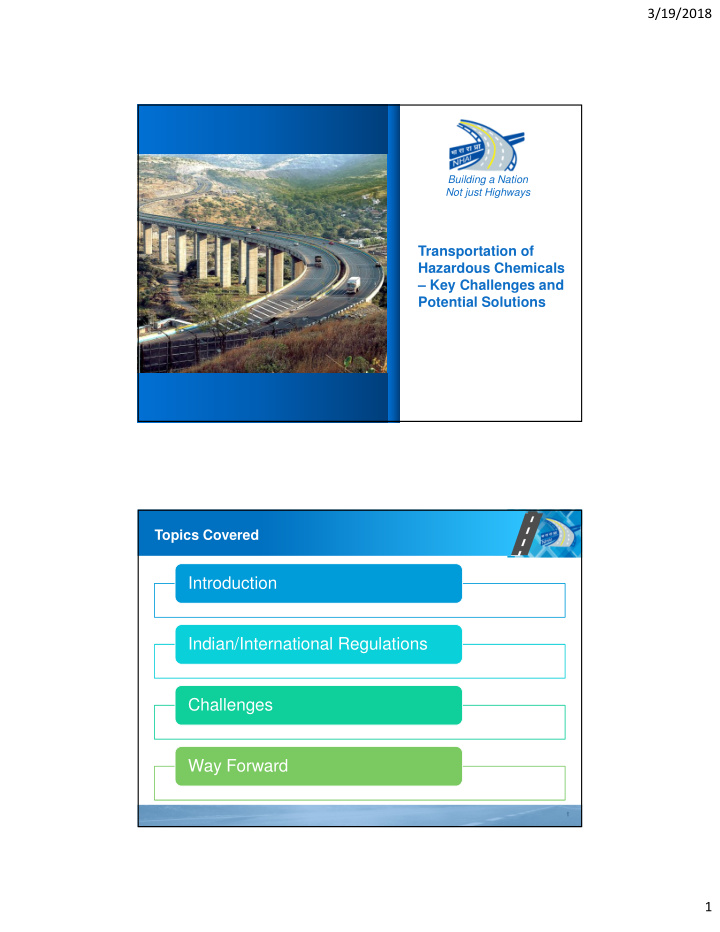



3/19/2018 Building a Nation Not just Highways Transportation of Hazardous Chemicals – Key Challenges and Potential Solutions Topics Covered `` Introduction Indian/International Regulations Challenges Way Forward 1 1
3/19/2018 Introduction `` � Chemical manufacturing is a non-stop process. Many of the chemicals are hazardous; still they are produced in large quantity. All sorts of safety measures and precautions can be taken at manufacturing stage. Next step is selling the products, which inescapably involves of transportation. Transportation of the Hazardous chemicals, therefore, is a serious subject as it not only involves a manufacturing but entire locality around during its transit. � Movement of any hazardous substance by any mode of transport involves a risk of accidental spillage of material or release of toxic chemicals , fire or explosion, � The intensity of catastrophe is more when mode of transport is by Road. 2 Challenges `` Untrained drivers Bad condition of vehicles Badly painted signage or Irrelevant information Vehicles parked in non-designated areas 3 2
3/19/2018 Common practices prevalent in the transport crew `` � No trained Drivers are employed for transportation � Drivers lack knowledge of Chemical they are carrying, unaware of hazards – e.g. washing hands with benzene to remove oil/grease. � The worst condition vehicles are deployed for carrying chemicals. � Obligation of fulfilling the statutory compliances are scanty � Tankers seen parked near Hotels, Schools, congested area, busy markets etc. � Drivers are seen smoking and even cooking near loaded trucks. � Tankers move on road with irrelevant information on “Emergency Information Panel” 4 Examples of Challenges `` Inaccurate Images Image does not match specs Unclear Photos 5 3
3/19/2018 Example of wrong information `` 6 EXAMPLES `` 7 4
3/19/2018 EXAMPLES `` 8 EXAMPLES `` 9 5
3/19/2018 THE REQUIREMENTS `` Legislation • Explosive Rules • Petroleum Rules • Gas Cylinder Rules • Central Motor Vehicle Rules • Chemical Accident Rules Emergency Response Center Training Public awareness 10 Indian Regulations `` Warnings to be displayed on the vehicle with following objectives • Warning to public to keep away • Indication of primary hazard for emergency service in an accidental situation HAZCHEM Code • Number from 1 to 4 and any one of the letters, P, R, S , T, W, X, Y, Z followed at times by the letter E 11 6
3/19/2018 Example `` • 2 – FOG equipment is recommended, though extinguishing agent with higher code may be The HAZCHEM recommended Code for • P – Can be Violently reactive. Full body clothing Ethylene Dioxide with breathing apparatus is necessary. (UN Code 1040) • The substance may be diluted and washed to is 2PE . drain. • E – Consider evacuation as the first priority. • 3 – Use foam only • Y – Can be violently reactive or explosive. Breathing apparatus + protective gear to be used Motor spirit has in case of fire The personnel protective HAXZCHEM equipment is a requirement in case of spillage. Code as 3YE . Any spillage of the substance should be contained.. • E – Consider evacuation as first priority. 12 Key Definitions `` Toxic Chemicals: Flammable chemicals: Explosives: • Chemicals having the “Extremely • Flammable gases ; chemicals • Chemicals which may explode Toxic” or “Highly Toxic” values of which in the gaseous state at under the effect of flame, heat or acute toxicity and which, owing normal pressure and mixed with photo-chemical conditions or to their physical and chemical air become flammable and the which are more sensitive to properties, are capable of boiling point of which at normal shocks or friction than producing major accidents pressure is 20° C or below; dinitrobenzene. hazards. • Highly flammable liquids : chemicals which have a flash point lower than 23° Cand the boiling point of which at normal pressure is above 20° C; • Flammable liquids: chemicals which have a flash point lower than 65° C, and which remain liquids under pressure, where particular processing conditions, such as high pressure and high temperature, may create major accident hazards. 13 Ministry of Environment, Forest and Climate Change (http://envfor.nic.in/legis/hsm/hsm2sch1.html) 7
3/19/2018 Material Classification `` • Class 1: Explosives • Class 2: Gases • Class 3: Flammable liquids • Class 4: Flammable solids, combustible materials, and materials that are dangerous when wet The Central Motor Vehicle • Class 5: Oxidisers and Organic Peroxides Rules 1989 • Class 6: Poisonous and Etiologic(Infectious) • Class 7: Radioactive • Class 8: Corrosives • Class 9: Miscellaneous Hazardous Material 14 Training : Roles and Responsibilities `` Goods carriage has Should verify vehicle Keep all information Consignor Transporter Driver valid registration. registration and safety provided to him in equipment. TREM card (Transport Emergency Card) Vehicle has necessary first-aid, Safety Should satisfy himself equipment, and anti- of accuracy of Ensure that the parked dote(s). Consignor information. vehicle is safe from fire, explosion, or any other risk. Has full information Owner and consignor about the goods being should lay down the carried. route for each trip in Should have ability to line with police read and write atleast authorities. one language specified Driver has adequate in Indian Constitution. training. 15 8
3/19/2018 Glimpse of Future Challenges `` Air pollution Integration of from fine transportation particulates, and logistics hydrocarbons, systems. CFC Emissions, etc. Water Waster contamination disposal from from cleaning terminal fluids and operations. sludge. 16 Way Forward –Trainings + Technology `` GIS based mapping of route OSHAS based model for trainings Annual, refresher, and specific Identifying risks with routes Way Forward Trainings Technical Interventions Evaluating alternate routes and Self certification + Institutions strategies Localised content + international best Deploying FASTags for even practices faster alerts 17 9
3/19/2018 Thank You Building a Nation Not just Highways 10
Recommend
More recommend